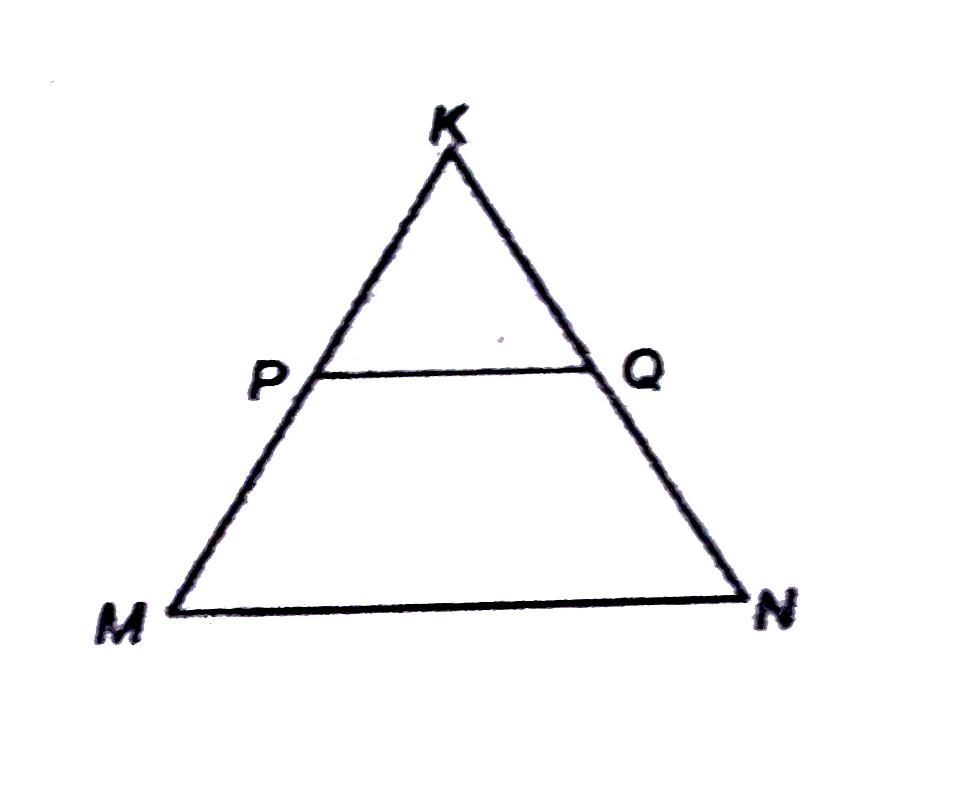In Figure is parallel to if and Find KQ.
To solve the problem step by step, we will use the Basic Proportionality Theorem (also known as Thales' theorem), which states that if a line is drawn parallel to one side of a triangle, it divides the other two sides proportionally.
1. Identify the Given Information:
- We have two parallel lines: PQ∥MN.
- The ratio KPPM=413.
- The length KN=20.4 cm.
2. Set Up the Proportionality:
- According to the Basic Proportionality Theorem:
KPPM=KQQN
- We can express QN in terms of KQ:
QN=KN−KQ
- Thus, we can rewrite the proportion:
KPPM=KQKN−KQ
3. Substitute the Known Values:
- Substitute KPPM=413 and KN=20.4:
413=KQ20.4−KQ
4. Cross-Multiply to Solve for KQ:
- Cross-multiplying gives:
4(20.4−KQ)=13KQ
- Expanding this:
81.6−4KQ=13KQ
5. Combine Like Terms:
- Rearranging the equation:
81.6=13KQ+4KQ
- This simplifies to:
81.6=17KQ
6. Solve for KQ:
- Dividing both sides by 17:
KQ=81.617
- Calculating the value:
KQ=4.8 cm
Final Answer:
Hence, the value of KQ is 4.8 cm.
- We have two parallel lines: PQ∥MN.
- The ratio KPPM=413.
- The length KN=20.4 cm.
- According to the Basic Proportionality Theorem:
KPPM=KQQN
- We can express QN in terms of KQ:
QN=KN−KQ
- Thus, we can rewrite the proportion:
KPPM=KQKN−KQ
- Substitute KPPM=413 and KN=20.4:
413=KQ20.4−KQ
- Cross-multiplying gives:
4(20.4−KQ)=13KQ
- Expanding this:
81.6−4KQ=13KQ
- Rearranging the equation:
81.6=13KQ+4KQ
- This simplifies to:
81.6=17KQ
- Dividing both sides by 17:
KQ=81.617
- Calculating the value:
KQ=4.8 cm
Hence, the value of KQ is 4.8 cm.
Topper's Solved these Questions
Similar Questions
In the figure PQ is parallel to MN if KPPM=413andKN=20.4.
Find KQ.

View SolutionIn Figure, find the measure of ∠MPN
View SolutionIn Figure, HELP is a parallelogram. If OE=4cm and HL is 5cm more then PE. Find OH.
View SolutionIn Figure, PQRS is a parallelogram, PO and QO are, respectively, the angle bisectors of ∠P and ∠Q . Line LOM is drawn parallel to PQ . Prove that:
(i) PL=QM
(ii) LO=OM
View SolutionIn Figure, AP is a tangent to the circle with centre O such that OP=4cm and ∠OPA=30∘ . Then, AP= (a)2√2cm (b)2cm (c)2√3cm (d)3√2cm
View SolutionIn Figure, PQRS is a parallelogram, PO and QO are, respectively, the angle bisectors of ∠P and ∠Q. Line LOM is drawn parallel to PQ. Prove that : PL=QM (ii) LO=OM
View SolutionIn Figure, it is given that LM=MN, QM=MR, ML ⊥PQ and MN ⊥PR. Prove that PQ=PR
View SolutionIn Figure, △ACB~△APQ . If BC=8cm , PQ=4cm , BA=6.5cm and AP=2.8cm , find CA and AQ .
View SolutionIn Figure, S and T are points on the sides PQ and PR respectively of △PQR such that PT=2cm , TR=4cm and ST is parallel to QR . Find the ratio of the areas of △PST and △PQR .
View SolutionIn Fig. 4.166, PB and QA are perpendiculars to segment AB. If PO=5cm , QO=7cm and Area POB=150 cm2 find the area of QOA . (FIGURE)
View Solution
